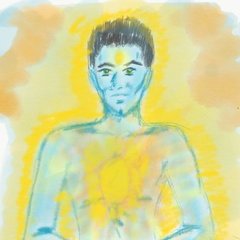-
Content count
8,286 -
Joined
-
Last visited
-
Days Won
70
Everything posted by dwai
-
When I was 3-4 years into my Tai chi journey, my first teacher's recommendation of "letting go" became very real for me. I realized that I had to "let go", in order to become empty (which is a big deal for tai chi/dao people) The baffling thing for me was, "How do I let go?" I'd ask my teacher and he would say "just let go", but I didn't understand what he meant exactly then. My present teacher too says, "letting go is easy, but is also kind of hard at the same time". I think the following section does a good job of explaining to me how to let go. The Sage Ashtāvakra, whose compendium (samhita), also known as Ashtāvakra Gita, is known for his simple and direct teachings of Nonduality. Now, Ashtāvakra is considered to be for those who have already spent significant time following the tripartite course of listening (to advaita teachings), contemplating (upon those teachings and understanding them intellectually) and meditation (making the teachings a living reality). The great Swami Chinmayānanda (founder of the Chinmāya Mission), wrote a beautiful commentary on the Ashtāvakra Gita, which is the reference material for this post. Ashtāvakra outlines 5 principles or guidelines by which one can let go of all phenomenal attachments. Ashtāvakra says, if your senses and mind are attached to any object, those objects are essentially poison (they bind you). So, they have to be let go. Here are his five principles (my own understanding of them) -- kshamā or forgiveness -- when something wrong happens through you, and you are aware of it, it is the hardest thing to forgive yourself for it. Forgive yourself. Not being able to forgive yourself, you bind yourself to the past. Arjava or sincerity -- Perform every action with full awareness. That itself is sincerity. Since you already know your true nature as being the ever-free awareness, when you operate from that point of presence, all action becomes totally sincere and pure (and nothing bad will come from it). Dayā or Compassion -- Don't be hard on yourself or others. Be compassionate towards all, including yourself. This rises from the understanding that there IS no one or nothing apart from you. So how can we be anything but compassionate? Thosha or Contentment -- Maintain the sense of fulfillment and contentment in your life, whatever the circumstances. If life's ups and downs frustrate you, then how can you remain compassionate? The example given is, consider that you are going to die in 10 days. What would your priorities be? Would you worry about property and money or what you eat etc? Be happy and live each day as it is, with full acceptance and joy. Truth -- What is truth? Whatever is, right now, in the present moment. Everything else is ephemeral. Change is inevitable. Death is inevitable. The body changes? The people change. Everything changes. Only what is now is real. Hold on to that.
- 13 replies
-
- 5
-

-

-
- ashtāvakra
- gita
-
(and 3 more)
Tagged with:
-
Learn Sanskrit and read the original Upanishads if you want to read “authentic” stuff. Since I’m not very smart, I rely on masters such as Swami chinmayananda, Swami vivekananda et al to elucidate the teachings. 👍🏾
- 13 replies
-
- 1
-

-
- ashtāvakra
- gita
-
(and 3 more)
Tagged with:
-
Ok 👍🏾
- 13 replies
-
- 1
-

-
- ashtāvakra
- gita
-
(and 3 more)
Tagged with:
-
Ok @rideforever, you obviously have some serious issues with swami chinmayananda in order to forgive others, you must learn to first forgive yourself. True forgiveness cannot arise from someone who judges and/or punishes him/herself and treats themselves unkindly. You know that old saying...”charity begins at home”?
- 13 replies
-
- 1
-

-
- ashtāvakra
- gita
-
(and 3 more)
Tagged with:
-
The actual sanskrit clearly says the following -- muktiṃ icchasi cettāta viṣayān viṣavattyaja । kṣamārjavadayātoṣasatyaṃ pīyūṣavad bhaja ॥ 1-2॥ It clearly outlines the words, Kshamā, arjava, dayā, tosha, and satyam (as provided in the OP). Sanskrit words are not ambiguous like english words. You should read a better commentary translation.
- 13 replies
-
- 1
-

-
- ashtāvakra
- gita
-
(and 3 more)
Tagged with:
-
https://www.medhajournal.com/you-are-never-not-that/
- 31 replies
-
- 1
-

-
- meditation
- taijiquan
-
(and 2 more)
Tagged with:
-
This is an article I wrote many years ago (11) during my early days of meditation. https://www.medhajournal.com/the-i-of-the-storm/ I strongly recommend for anyone who is struggling currently to persevere and do more studying of nondual texts, along with their regular meditation practice. It might help you resolve these sort of “issues” sooner.
- 31 replies
-
- 3
-

-
- meditation
- taijiquan
-
(and 2 more)
Tagged with:
-
-
Most insightful. Koshas are only one way. There are other techniques used too, depending on the individual.
-
Samkhya is a foundation of Hindu dharma. Majority of theoretical basis of Hindu darshana comes from samkhya. Buddha too was first a student of samkhya. So is a common framework there.
-
Yeah got it. But it gets murky because Buddhism uses many Hindu words In any case, the process is the same, just a bit more details, and that’s important when we do self inquiry in the vedantic way. One of the methods is to observe the five sheaths (koshas) where the four components namely manas, Chitta, buddhi and ahamkara play a big role.
-
“Chit”, not “chitta”. Chitta literally is the storehouse of impressions. Chit is consciousness. It seems like a minor difference but is not. It is our intellect (buddhi) that does the cognizing. It is done in the mind (manas) as thoughts. Overall very interesting idea.
-
Awareness as is used in the eastern traditions is pure objectless consciousness. This and that come as a result of it. The technical term for it is “chit” or “chaitanya”. The conditioned consciousness (of this and that) is a composite of four functions/processes that emerge from chaitanya - mind or manas (the field of thoughts), ego or ahamkara (that identifies with this or that), Chitta ie impression storehouse (which stores all the impressions and memories that arise in the manas. Finally is buddhi or intellect, that allows conceptualization and comprehension (like what the reader would use to understand what I just wrote). It’s like a finger pointing to your own self nature (or if you are a Buddhist, your “not self”). So not so much introducer, more like a guide. There are many ways of doing this, it varies from tradition to tradition. Some have the master speak. When words come from awakeness, the awakeness within the listener becomes revealed. Some do it via mind stream transmission. Some do it via physical touch (like my master did to me).
-
How does one know one has eyes? The greatest joke is of personalities trying to become enlightened. As long as we don’t see that the personality is just a veil, an appearance/mask, we can’t know our true nature. The true nature is always and already enlightened/liberated/awakened.
- 31 replies
-
- 2
-

-
- meditation
- taijiquan
-
(and 2 more)
Tagged with:
-
I’m in the California Bay Area for a couple of weeks. And I found myself drawn to a particular large redwood tree. Standing about 10-15 feet from it, as I connected with it, I could feel it’s field. Was very yang and very palpable. As I did my forms, I felt the yang Qi expanding inside me. My feet got very hot, so I took my shoes off and did the rest of my workout on the grass, and it felt real good. I’ve worked with it a couple days so far, and it’s been a very amazing experience so far. I’ve not really done tree qigong before, so wondering if we can categorize trees into yin or yang characteristics, and if so, which type of tree should we approach if we want to balance yin and yang energies within us?
-
I have 3 primary practices that have now melded with each other. Taijiquan and daogong (Daoist meditations) abiding as awareness which includes Meditation on the different states (waking, dreaming and deep sleep) of awareness and the background thereof meditation on the five sheaths (koshas) and the awareness that underlies them meditation on subject-object discernment and the underlying awareness as the pure subject meditation on sentience-insentience discernment and the underlying sentience/awareness thereof Merging with deities Taijiquan and daogong work on approaching awareness from the energetic (life force and spirit) perspective. The ‘abiding as awareness’ and the sub-methods thereof work directly with the mind and recognizing the underlying awareness as the self nature. Merging with deities helps with handling the vicissitudes of life and with self surrender (Bhakti).
-
Any position taken, can be reduced to the absurd (reductio ad absurdum). Best to simply stick with what one knows to as working for oneself and forget the speculation. My 2 cents worth...
-
Enjoy!
-
In the advanced text of Advaita Vedanta, titled “jivanamukti Viveka”, the author, Vidyāranya Swami lays down three requisites for liberation, enlightenment, awakening. The three are — Self knowledge, jñāna dropping of vāsanās, or habitual patterns of the mind that appear in the form of compulsive behaviors and cravings Cessation of the mind, in the sense the mind stops clinging to things According to the book, all three must happen simultaneously, and not sequentially. However, depending on whether one is a seeker or a knower (jñāni), the emphasis is on different components of the triumvirate. While for the seeker, the primary emphasis is on gaining the knowledge (via studying the texts, transmission from a realized master, contemplation and meditation), along with cessation of the mind, for one who has realized the Self already, the emphasis is on dropping the habitual patterns of behavior that arise from activated karma.
-
- 31 replies
-
- 1
-

-
- meditation
- taijiquan
-
(and 2 more)
Tagged with:
-
It so turned out that there were no “two I’s” anyway. The one I that was, has always been and will always be. It was just a case of not knowing what that real “ I” (witness) was. It is that way with most folks it seems. The ego (who claims doership) is just a process. The observer and the observation are essentially the same ...like the sun and it’s light.
- 31 replies
-
- 5
-

-

-
- meditation
- taijiquan
-
(and 2 more)
Tagged with:
-
In taiji it becomes the natural state (to remain in the present all the time). Taiji automatically puts us into sākshi bhāva, and from there slowly all modifications of the mind can be released. But as with anything else, we get back what we put into it. Most important is to have a good teacher, and a committed personal daily practice. Not complicated at all. People’s minds are complicated, that’s all I think it’s a case of a system that works best for an individual at a given time (based on various conditions, such as karmaphala, etc).
-
They are not mutually exclusive. Tai chi is a type of qigong, and you get to meditate while moving, which may or may not be part of a qigong set.
-
Done
-
I’ve got several. They can’t be downloaded but are accessible on your account online.


